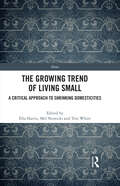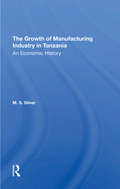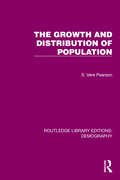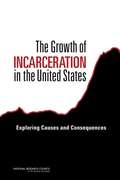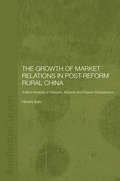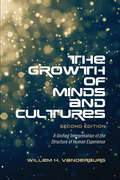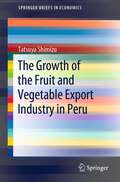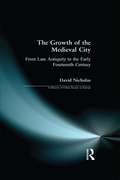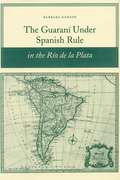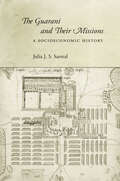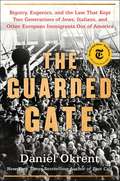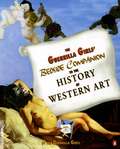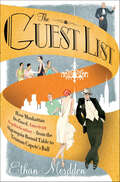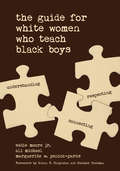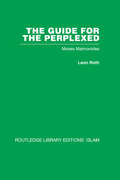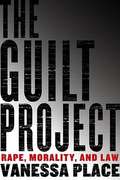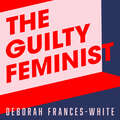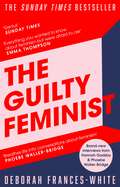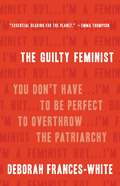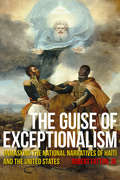- Table View
- List View
The Growing Trend of Living Small: A Critical Approach to Shrinking Domesticities (Home)
by Ella Harris Mel Nowicki Tim WhiteThis book examines the growing trend for housing models that shrink private living space and seeks to understand the implications of these shrinking domestic worlds. Small spaces have become big business. Reducing the size of our homes, and the amount of stuff within them, is increasingly sold as a catch-all solution to the stresses of modern life and the need to reduce our carbon footprint. Shrinking living space is being repackaged in a neoliberal capitalist context as a lifestyle choice rather than the consequence of diminishing choice in the face of what has become a long-term housing ‘crisis’. What does this mean for how we live in the long term, and is there a dark side to the promise of a simpler, more sustainable home life? Shrinking Domesticities brings together research from across the social sciences, planning and architecture to explore these issues. From co-living developments to the Tiny House Movement, self-storage units to practices of ‘de-stuffification’, and drawing on examples from across Europe, North America and Australasia, the authors of this volume seek to understand both what micro-living is bringing to our societies, and what it may be eroding
The Growth Of The Manufacturing Industry In Tanzania: An Economic History
by M. S. Silver M S SilverTracing the evolution of the Tanzanian manufacturing industry since the beginning of colonial rule, this book focuses on the period since independence and especially on the effects of socialist policies resulting from the 1967 Arusha Declaration. Dr. Silver develops volume indices of production for Tanzanian industry as a whole and for individual sectors. He also examines in detail changes in labor productivity, earnings, unit labor costs, investments, and the prices of manufactured goods, paying special attention to the role of government-controlled parastatals, the regional distribution of manufacturing industries, and income inequality. The rapid growth in production and employment and the changing structure of the manufacturing industry, he concludes, is due to high rates of investment in a small number of relatively large establishments, primarily in the parastatal sector.
The Growth and Distribution of Population (Routledge Library Editions: Demography #10)
by S. Vere PearsonOriginally published in 1935, this book examines the causes of global rural depopulation, slum housing conditions and city over-crowding. The falling birth-rate in the West, town planning, ribbon development, emigration and traffic problems are also discussed with particular focus on how they affect the growth and distribution of populations. Social, psychological and economic factors are all considered, as well as those dependent on physical geography.
The Growth of Incarceration in the United States
by Committee on Causes Consequences of High Rates of IncarcerationAfter decades of stability from the 1920s to the early 1970s, the rate of imprisonment in the United States has increased fivefold during the last four decades. The U. S. penal population of 2. 2 million adults is by far the largest in the world. Just under one-quarter of the world's prisoners are held in American prisons. The U. S. rate of incarceration, with nearly 1 out of every 100 adults in prison or jail, is 5 to 10 times higher than the rates in Western Europe and other democracies. The U. S. prison population is largely drawn from the most disadvantaged part of the nation's population: mostly men under age 40, disproportionately minority, and poorly educated. Prisoners often carry additional deficits of drug and alcohol addictions, mental and physical illnesses, and lack of work preparation or experience. The growth of incarceration in the United States during four decades has prompted numerous critiques and a growing body of scientific knowledge about what prompted the rise and what its consequences have been for the people imprisoned, their families and communities, and for U. S. society. The Growth of Incarceration in the United States examines research and analysis of the dramatic rise of incarceration rates and its affects. This study makes the case that the United States has gone far past the point where the numbers of people in prison can be justified by social benefits and has reached a level where these high rates of incarceration themselves constitute a source of injustice and social harm. The Growth of Incarceration in the United States examines policy changes that created an increasingly punitive political climate and offers specific policy advice in sentencing policy, prison policy, and social policy. The report also identifies important research questions that must be answered to provide a firmer basis for policy. This report is a call for change in the way society views criminals, punishment, and prison. This landmark study assesses the evidence and its implications for public policy to inform an extensive and thoughtful public debate about and reconsideration of policies.
The Growth of Market Relations in Post-Reform Rural China: A Micro-Analysis of Peasants, Migrants and Peasant Entrepeneurs (Routledge Studies on the Chinese Economy)
by Hiroshi SatoThis book, based on in-depth field research at the local level, assesses the different factors that are contributing to the transition to a market economy and the growth of networks in rural China. It analyses the different socio-economic actors - peasant households, out-migrants, family businesses and peasant entrepreneurs, uses the key concept of markets as a nexus of social networks, and identifies three different kinds of 'social capital' - human capital, political capital/status, and network capital.This book demonstrates the importance of socio-political networks and highlights significant regional differences.
The Growth of Minds and Culture: A Unified Interpretation of the Structure of Human Experience
by Willem H. VanderburgThe impact of science and technology on culture raises a number of questions about the ways in which people relate to each other and to their environment. Such questions cannot be answered by traditional approaches. Thus another level of analysis is needed to complement the traditional approaches and to address future challenges. The first step in creating this new analysis was taken by Willem H. Vanderburg in 1985 with his pioneering work The Growth of Minds and Cultures. In this book, the first of a multi-volume series that includes Our Battle for the Human Spirit (2016), Vanderburg shows how the culture of a society underlies its science, technology, economy, social structure, political institutions, morality, religion, and art. As such, he seeks to build bridges not only between the ‘two cultures’ but between all the sciences in order to gain a deeper understanding of our age. This expanded second edition makes the author’s ground-breaking analysis available to a generation of digital natives.
The Growth of the Fruit and Vegetable Export Industry in Peru (SpringerBriefs in Economics)
by Tatsuya ShimizuThis is the first book that analyzes the growth of the Peruvian fresh fruit and vegetable (FFV) export industry from the view point of the industrial development. Instead of pointing out comparative advantages in production factors such as favorable climate and cheap labor, this book focuses on the strategies of agribusiness companies, industrial organizations, and the public sector in the FFV export industry. The analysis is based on the theoretical frameworks of coordination, integration, and upgrades in value chains, business strategies to overcome seasonality and mitigate risks in agriculture, and cluster development based on joint actions among players in the industry. Based on the field studies with major FFV production and export companies and industrial organizations, the case studies describe specific innovations in management and organizations taken by key actors in the industry. This book can help policymakers in developing countries seek industrial development options based on agricultural exports.
The Growth of the Medieval City: From Late Antiquity to the Early Fourteenth Century (A History of Urban Society in Europe)
by David M NicholasThe first part of David Nicholas's massive two-volume study of the medieval city, this book is a major achievement in its own right. (It is also fully self-sufficient, though many readers will want to use it with its equally impressive sequel which is being published simultaneously.) In it, Professor Nicholas traces the slow regeneration of urban life in the early medieval period, showing where and how an urban tradition had survived from late antiquity, and when and why new urban communities began to form where there was no such continuity. He charts the different types and functions of the medieval city, its interdependence with the surrounding countryside, and its often fraught relations with secular authority. The book ends with the critical changes of the late thirteenth century that established an urban network that was strong enough to survive the plagues, famines and wars of the fourteenth and fifteenth centuries.
The Guaraní Under Spanish Rule in the Río De La Plata
by Barbara Anne GansonThis ethnographic study is a revisionist view of the most significant and widely known mission system in Latin America--that of the Jesuit missions to the Guaraní Indians, who inhabited the border regions of Paraguay, Argentina, and Brazil. It traces in detail the process of Indian adaptation to Spanish colonialism from the sixteenth through the early nineteenth centuries. The book demonstrates conclusively that the Guaraní were as instrumental in determining their destinies as were the Catholic Church and Spanish bureaucrats. They were neither passive victims of Spanish colonialism nor innocent "children" of the jungle, but important actors who shaped fundamentally the history of the Río de la Plata region. The Guaraní responded to European contact according to the dynamics of their own culture, their individual interests and experiences, and the changing political, economic, and social realities of the late Bourbon period.
The Guaraní and Their Missions
by Julia J. S. SarrealThe thirty Guaraní missions of the Río de la Plata were the largest and most prosperous of all the Catholic missions established throughout the frontier regions of the Americas to convert, acculturate, and incorporate indigenous peoples and their lands into the Spanish and Portuguese empires. But between 1768 and 1800, the mission population fell by almost half and the economy became insolvent. This unique socioeconomic history provides a coherent and comprehensive explanation for the missions' operation and decline, providing readers with an understanding of the material changes experienced by the Guaraní in their day-to-day lives. Although the mission economy funded operations, sustained the population, and influenced daily routines, scholars have not focused on this important aspect of Guaraní history, primarily producing studies of religious and cultural change. This book employs mission account books, letters, and other archival materials to trace the Guaraní mission work regime and to examine how the Guaraní shaped the mission economy. These materials enable the author to poke holes in longheld beliefs about Jesuit mission management and offer original arguments regarding the Bourbon reforms that ultimately made the missions unsustainable.
The Guarded Gate: Bigotry, Eugenics and the Law That Kept Two Generations of Jews, Italians, and Other European Immigrants Out of America
by Daniel OkrentBy the widely celebrated New York Times bestselling author of Last Call—the powerful, definitive, and timely account of how the rise of eugenics helped America close the immigration door to “inferiors” in the 1920s.A forgotten, dark chapter of American history with implications for the current day, The Guarded Gate tells the story of the scientists who argued that certain nationalities were inherently inferior, providing the intellectual justification for the harshest immigration law in American history. Brandished by the upper class Bostonians and New Yorkers—many of them progressives—who led the anti-immigration movement, the eugenic arguments helped keep hundreds of thousands of Jews, Italians, and other unwanted groups out of the US for more than 40 years. Over five years in the writing, The Guarded Gate tells the complete story from its beginning in 1895, when Henry Cabot Lodge and other Boston Brahmins launched their anti-immigrant campaign. In 1921, Vice President Calvin Coolidge declared that “biological laws” had proven the inferiority of southern and eastern Europeans; the restrictive law was enacted three years later. In his characteristic style, both lively and authoritative, Okrent brings to life the rich cast of characters from this time, including Lodge’s closest friend, Theodore Roosevelt; Charles Darwin’s first cousin, Francis Galton, the idiosyncratic polymath who gave life to eugenics; the fabulously wealthy and profoundly bigoted Madison Grant, founder of the Bronx Zoo, and his best friend, H. Fairfield Osborn, director of the American Museum of Natural History; Margaret Sanger, who saw eugenics as a sensible adjunct to her birth control campaign; and Maxwell Perkins, the celebrated editor of Hemingway and Fitzgerald. A work of history relevant for today, The Guarded Gate is an important, insightful tale that painstakingly connects the American eugenicists to the rise of Nazism, and shows how their beliefs found fertile soil in the minds of citizens and leaders both here and abroad.
The Guerrilla Girls' Bedside Companion to the History of Western Art
by Guerrilla GirlsTaking you back through the ages, The Guerrilla Girls demonstrate how males have dominated the art scene and discouraged or obscured women's involvement. Their sceptical and hilarious interpretaions are augmented by other feminists.
The Guest List: How Manhattan Defined American Sophistication—from the Algonquin Round Table to Truman Capote's Ball
by Ethan MorddenFrom the 1920s to the early 1960s, Manhattan was America's beacon of sophistication. From the theatres of Broadway to the lobby of the Algonquin Hotel to tables at the Stork Club, intelligence and wit were the twinned coins of the realm. Alexander Woolcott, Irving Berlin, Edna Ferber, Arturo Toscanini, Leonard Bernstein, Cole Porter, Dorothy Parker, Truman Capote, the Lunts and Helen Hayes presided over the town. Their books, plays, performances, speeches, dinner parties, masked balls, loves, hates, likes and dislikes became the aspirations of a nation. If you wanted to be sophisticated, you played by Manhattan's rules. If you didn't, you simply weren't on the guest list. The Heartland rebelled against Manhattan's dictum, but never prevailed. In this lively cultural history, Mordden chronicles the city's most powerful and influential era.
The Guide for White Women Who Teach Black Boys
by Marguerite W. Penick-Parks Eddie Moore Jr. Ali MichaelSchools that routinely fail Black boys are not extraordinary. In fact, they are all-too ordinary. If we are to succeed in positively shifting outcomes for Black boys and young men, we must first change the way school is “done.” That’s where the eight in ten teachers who are White women fit in . . . and this urgently needed resource is written specifically for them as a way to help them understand, respect and connect with all of their students. <p><p> So much more than a call to call to action—but that, too!—The Guide for White Women Who Teach Black Boys brings together research, activities, personal stories, and video interviews to help us all embrace the deep realities and thrilling potential of this crucial American task.
The Guide for the Perplexed: Moses Maimonides
by Leon RothOriginally published in 1948. Moses Maimonides was one of the most powerful philosophers of the Middle Ages. The philosophical basis which he elaborated for Judaism had a profound influence on mediaeval Christian thinkers. This volume describes the full background of Maimonides’s thinking in its twelfth-century historical and religious context.
The Guilt Project: Rape, Morality, and Law
by Vanessa PlaceAn English court in 1736 described rape as an accusation "easily to be made and hard to be proved, and harder to be defended by the party accused, though never so innocent." To prove the crime, the law required a woman to physically resist, to put up a "hue and cry," as evidence of her unwillingness. Beginning in the 1970s, however, feminist and victim-advocacy groups began changing attitudes toward rape so the crime is now seen as violent in itself: the legal definition of rape now includes everything from the sadistic serial rapist to the eighteen-year-old who has consensual sex with a fourteen-year-old. This inclusiveness means there are now more rapists among us. And more of rape's camp followers: the prison-makers, the community watchdogs, law-and-order politicians, and the real-crime/real-time entertainment industry. Vanessa Place examines the ambiguity of rape law by presenting cases where guilt lies, but lies uneasily, and leads into larger ethical questions of what defines guilt, what is justice, and what is considered just punishment. Assuming a society can and must be judged by the way it treats its most despicable members, The Guilt Project looks at the way the American legal system defines, prosecutes, and punishes sex offenders, how this Dateline NBC justice has transformed our conception of who is guilty and how they ought to be treated, and how this has come to undo our deeper humanity.
The Guilty Feminist: The Sunday Times bestseller - 'Breathes life into conversations about feminism' (Phoebe Waller-Bridge)
by Deborah Frances-WhiteTHE SUNDAY TIMES BESTSELLER'Breathes life into conversations about feminism' PHOEBE WALLER-BRIDGE'Very funny, very clever, very thoughtful and very relevant' DOLLY ALDERTONWhy do we find it so hard to say 'No'?How can feminism be more inclusive?What can rom-coms tell us about taking charge?The Guilty Feminist will challenge you, reassure you and empower you to see the world differently.From inclusion to intersectionality, #MeToo to men's rights, rom-coms to pornography, Deborah Frances-White tackles urgent questions for the modern woman. Featuring interviews with activists, businesswomen and all-round inspirations, The Guilty Feminist examines how women can abandon their guilt, say No (when they mean it), say Yes (when they want to), and to change the world - and ourselves - for the better.Includes interviews with Jessamyn Stanley * Zoe Coombs Marr * Susan Wokoma * Phoebe Waller-Bridge * Hannah Gadsby * Reubs Walsh * Bisha K. Ali * Becca Bunce * Mo Mansfield * Leyla Hussein * Amika George'Genius' Sunday Times'Funny, fresh, thought-provoking' Observer'Everything you wanted to know about feminism but were afraid to ask' EMMA THOMPSON'Quite possibly the defining feminist of our generation' ELIZABETH DAY'Encouraging every woman to say: "I get to be heard. I deserve to be seen" ' Daily Express'A passionate and engaging manifesto, reminding readers that feminism isn't one-size-fits-all' I
The Guilty Feminist: The Sunday Times bestseller - 'Breathes life into conversations about feminism' (Phoebe Waller-Bridge)
by Deborah Frances-White***Coming in April 2025: Deborah Frances-White's new book SIX CONVERSATIONS WE'RE SCARED TO HAVE***THE SUNDAY TIMES BESTSELLER'Breathes life into conversations about feminism' PHOEBE WALLER-BRIDGE'Very funny, very clever, very thoughtful and very relevant' DOLLY ALDERTONWhy do we find it so hard to say 'No'?How can feminism be more inclusive?What can rom-coms tell us about taking charge?The Guilty Feminist will challenge you, reassure you and empower you to see the world differently.From inclusion to intersectionality, #MeToo to men's rights, rom-coms to pornography, Deborah Frances-White tackles urgent questions for the modern woman. Featuring interviews with activists, businesswomen and all-round inspirations, The Guilty Feminist examines how women can abandon their guilt, say No (when they mean it), say Yes (when they want to), and to change the world - and ourselves - for the better.Includes interviews with Jessamyn Stanley * Zoe Coombs Marr * Susan Wokoma * Phoebe Waller-Bridge * Hannah Gadsby * Reubs Walsh * Bisha K. Ali * Becca Bunce * Mo Mansfield * Leyla Hussein * Amika George'Genius' Sunday Times'Funny, fresh, thought-provoking' Observer'Everything you wanted to know about feminism but were afraid to ask' EMMA THOMPSON'Quite possibly the defining feminist of our generation' ELIZABETH DAY'Encouraging every woman to say: "I get to be heard. I deserve to be seen" ' Daily Express'A passionate and engaging manifesto, reminding readers that feminism isn't one-size-fits-all' I
The Guilty Feminist: You Don't Have to Be Perfect to Overthrow the Patriarchy
by Deborah Frances-Whitep.p1 {margin: 0.0px 0.0px 0.0px 0.0px; font: 12.0px 'Times New Roman'} A witty take on feminism for every woman who wants equality but sometimes wants a day off from fighting for it p.p1 {margin: 0.0px 0.0px 0.0px 0.0px; font: 12.0px 'Times New Roman'} p.p2 {margin: 0.0px 0.0px 0.0px 0.0px; font: 12.0px 'Times New Roman'; min-height: 15.0px} Sometimes we feel a bit like "I'm a feminist, but..." As in, "I'm a feminist, but I skipped the Women's March to buy face cream." As in, "I'm a feminist, but I've never found time to read Sylvia Plath (but I have watched fifteen seasons of Keeping Up with the Kardashians)." In The Guilty Feminist, Deborah Frances-White reassures us that we don't have to be perfect to be a force for meaningful change. Exploring big issues of identity, equality, intersectionality, and the current feminist agenda, she explodes the myth of the model activist and offers a realistic path toward changing the world.
The Guise of Exceptionalism: Unmasking the National Narratives of Haiti and the United States (Critical Caribbean Studies)
by Robert FattonThe Guise of Exceptionalism compares the historical origins of Haitian and American exceptionalisms. It also traces how exceptionalism as a narrative of uniqueness has shaped relations between the two countries from their early days of independence through the contemporary period. As a social invention, it changes over time, but always within the parameters of its original principles.
The Gujarat Carnage
by Asghar Ali EngineerIn February 2002, 59 Hindu pilgrims were burnt alive in a rail coach at Godhra. The National Human Rights Commission investigated the episode. This is a compilation of reports, surveys, and other significant material on the carnage.
The Gulag after Stalin: Redefining Punishment in Khrushchev’s Soviet Union, 1953-1964
by Jeffrey S. HardyIn The Gulag after Stalin, Jeffrey S. Hardy reveals how the vast Soviet penal system was reimagined and reformed in the wake of Stalin's death. Hardy argues that penal reform in the 1950s was a serious endeavor intended to transform the Gulag into a humane institution that reeducated criminals into honest Soviet citizens. Under the leadership of Minister of Internal Affairs Nikolai Dudorov, a Khrushchev appointee, this drive to change the Gulag into a "progressive" system where criminals were reformed through a combination of education, vocational training, leniency, sport, labor, cultural programs, and self-governance was both sincere and at least partially effective. The new vision for the Gulag faced many obstacles. Reeducation proved difficult to quantify, a serious liability in a statistics-obsessed state. The entrenched habits of Gulag officials and the prisoner-guard power dynamic mitigated the effect of the post-Stalin reforms. And the Soviet public never fully accepted the new policies of leniency and the humane treatment of criminals. In the late 1950s, they joined with a coalition of party officials, criminologists, procurators, newspaper reporters, and some penal administrators to rally around the slogan “The camp is not a resort” and succeeded in reimposing harsher conditions for inmates. By the mid-1960s the Soviet Gulag had emerged as a hybrid system forged from the old Stalinist system, the vision promoted by Khrushchev and others in the mid-1950s, and the ensuing counterreform movement. This new penal equilibrium largely persisted until the fall of the Soviet Union.
The Gulf Cooperation Council: Moderation And Stability In An Interdependent World
by John A. SandwickThe Gulf Cooperation Council represents both a model of development and unity in the Arab world and a working example of interstate cooperation to other nations. In this volume, contributors describe the rationale for Gulf unity and cooperation and analyze the financial, economic, and legal institutions of the GCC member states (Saudi Arabia, Kuwait, the United Arab Emirates, Oman, Bahrain, and Qatar). They focus on the GCC's role in maintaining stability in the Arabian peninsula, an area that is clearly vital to U.S. interests. Contributors pinpoint the essential elements of GCC unity, including its efforts to obtain optimum economic self-sufficiency, to maximize market share and revenue from oil production, and to establish an integrated legal framework. The GCC's unique security needs, given the member states' vast combined area and thinly spread populations, are also discussed. An overview of the strategic interests and policies of both superpowers toward the region reveals a history of decline in their influence and prestige that is a result, it is argued, of misperceptions and misguided policies. Finally, documentation and bibliographic sections enhance the book's usefulness as a handbook on the GCC and the Arabian Gulf states.
The Gulf Crisis and its Global Aftermath (Routledge Library Editions: The Gulf #6)
by Gad Barzilai Aharon Klieman Gil ShidloThe crisis in the Gulf of 1990-1 affected more than just the regional powers in the area. Rippling outward, its military, economic and political effects were felt throughout the international political system, testing US steadfastness in the face of Saddam Hussein’s political survival, European ability to form a united front on foreign policy issues and the effectiveness of the UN in confronting international aggression. The rationale behind this book, first published in 1993, is to investigate and analyse the various aspects of the crisis, especially in regard to the interactions between internal and international prospects for a new order in the Middle East. It also examines the wider effects of the war, and includes analysis of Europe, America and the Soviet Union. Each one of the essays chosen for this volume has been written by an expert in their field. This collaboration between historians, regional specialists and political scientists, integrating a variety of research methods in the framework of one book, will be useful to a wide range of readers.
The Gulf States and Oman (Routledge Library Editions: History of the Middle East #6)
by Christine OsborneThe discovery of oil brought enormous change to the Gulf. It transformed the simple fishing and grazing economies of the Gulf states into some of the wealthiest countries in the world. This book, first published in 1977, examines the impact of oil and oil wealth on the Gulf states. It describes the clash between traditional culture and Westernisation and explodes some of the Western myths about social and economic development in the area. It covers both economic change and progress in education, social welfare, urbanisation and industrial diversification. A unique collection of photographs accompanies the authoritative text.
